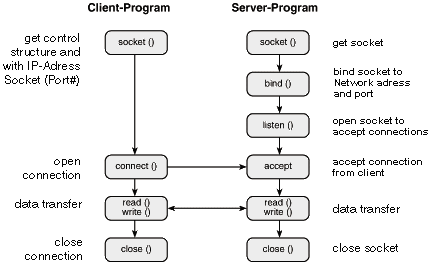This section contains the complete source code for the TCP/IP Client and Server applications: • • The server application should be started before the client application is started. To execute the server, compile the complete server source code and run the executable file. The server application listens on TCP port 27015 for a client to connect.

TCP/IP Client Socket Program. Here My Main Requirement is Client Send Message and server receive message and store in database table in C#.Net, Using Server IP Address and Port Number. Thanks one and all. Running the complete TCP/IP client and server application sample. Running the Winsock Client and Server Code Sample. The server shuts down the client socket. Example - Echo using stream socket Client 1. Create a TCP socket 2. Establish connection 3. Communicate 4. Close the connection Server 1. Create a TCP socket 2. Example of Client-Server Program in C. Internet domain 2) Stream socket 3) Default protocol (TCP in. (“IP address”); in your client and server program so it.
Once a client connects, the server receives data from the client and echoes (sends) the data received back to the client. When the client shuts down the connection, the server shuts down the client socket, closes the socket, and exits. To execute the client, compile the complete client source code and run the executable file. The client application requires that name of the computer or IP address of the computer where the server application is running is passed as a command-line parameter when the client is executed. If the client and server are executed on the sample computer, the client can be started as follows: client localhost The client tries to connect to the server on TCP port 27015.
Once the client connects, the client sends data to the server and receives any data send back from the server. The client then closes the socket and exits. Related topics.
Member 9961058 2-Apr-13 18:29 2-Apr-13 18:29 'Although the listen() function is the easiest way to listen on a port and act as the server, it is not the most desirable.' This is complete nonsense. Listen() is the only way to 'listen on a port and act as a server'. You will quickly find out when you attempt it that your program will freeze until an incoming connection is made. No, you won't find that out.
Your program will not freeze at that point. Because listen() is a 'blocking' function – it can only perform one task at a time, and will not return until a connection is pending. Listen() is not a blocking function, and it returns immediately. This is definitely a problem No it isn't. You can then specify, with the next and final parameter, how many remote computers can communicate with your server at the same time No you can't.
That's not what the parameter is for. It suggests a value for the size of the backlog queue. We just pass SOMAXCONN (SOcket MAX CONNection) as the final parameter to listen(). No we don't, not unless we want to drive the kernel crazy and waste huge amounts of memory. SOMAXCONN is 0x7fffffff. The usual size for the backlog queue is a few hundred.
When a connection request received, listen() will return listen() returns immediately whether there is a connection request or not. //Now we can start listening (allowing as many connections as possible to //be made at the same time using SOMAXCONN). You could specify any //integer value equal to or lesser than SOMAXCONN instead for custom //purposes).
The function will not //return until a connection request is //made Complete nonsense. If you compile and run this code, as mentioned before, your program will freeze until a connection request is made. Complete and utter nonsense. Obviously you never even tried it. Because using blocking functions such as listen() is so impractical It isn't a blocking function and it isn't impractical. Crack Staad Pro V8i Ss316l here. I'm obliged to keep repeating myself here because you have repeated the error so often that it requires attention called to it. Making a socket asynchronous simply requires an additional line of code after the listen() function.